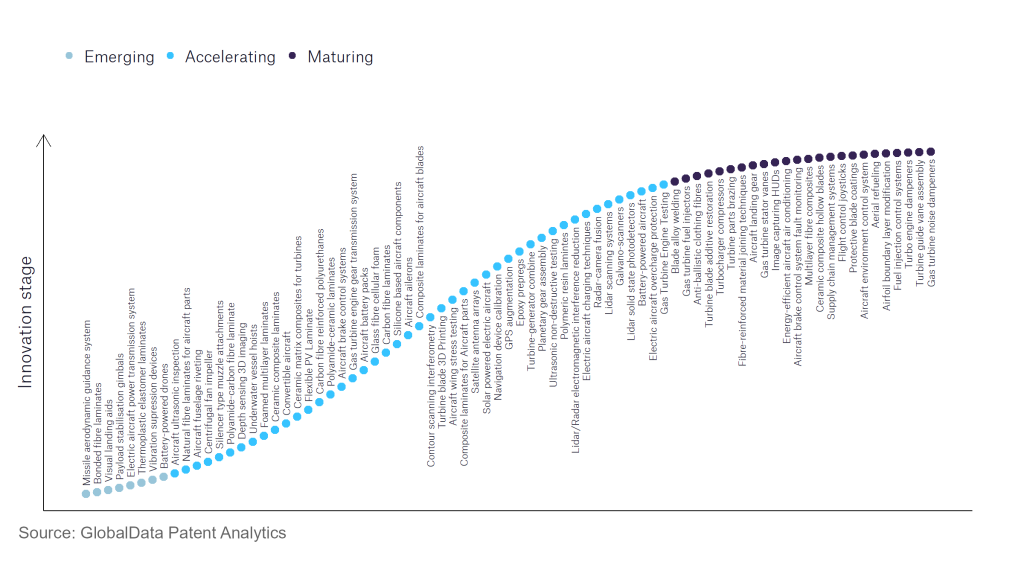The aerospace and defence industry continues to be a hotbed of innovation, with activity driven by the uptake of advanced technology, and growing importance of technologies such as hypersonics and advanced materials. In the last three years alone, there have been over 174,000 patents filed and granted in the aerospace and defence industry, according to GlobalData’s report on Robotics in Aerospace, Defence & Security: Aircraft power load balancing. Buy the report here.
However, not all innovations are equal and nor do they follow a constant upward trend. Instead, their evolution takes the form of an S-shaped curve that reflects their typical lifecycle from early emergence to accelerating adoption, before finally stabilising and reaching maturity.
Identifying where a particular innovation is on this journey, especially those that are in the emerging and accelerating stages, is essential for understanding their current level of adoption and the likely future trajectory and impact they will have.
180+ innovations will shape the aerospace and defence industry
According to GlobalData’s Technology Foresights, which plots the S-curve for the aerospace and defence industry using innovation intensity models built on over 262,000 patents, there are 180+ innovation areas that will shape the future of the industry.
Within the emerging innovation stage, bonded fibre laminates, thermoplastic elastomer laminates, and vibration supression devices are disruptive technologies that are in the early stages of application and should be tracked closely. Centrifugal fan impellers, ceramic composite laminates, and gas turbine engine testing are some of the accelerating innovation areas, where adoption has been steadily increasing. Among maturing innovation areas are protective blade coatings and blade alloy welding, which are now well established in the industry.
Innovation S-curve for the aerospace and defence industry

Aircraft power load balancing is a key innovation area in aerospace and defence
Load balancing, load matching or daily peak demand reserve means when the electrical power stations store excess power during period of low demand, and then release electrical power as needed when demand arises.
GlobalData’s analysis also uncovers the companies at the forefront of each innovation area and assesses the potential reach and impact of their patenting activity across different applications and geographies. According to GlobalData, there are 10+ companies, spanning technology vendors, established aerospace and defence companies, and up-and-coming start-ups engaged in the development and application of aircraft power load balancing.
Key players in aircraft power load balancing – a disruptive innovation in the aerospace and defence industry
‘Application diversity’ measures the number of different applications identified for each relevant patent and broadly splits companies into either ‘niche’ or ‘diversified’ innovators.
‘Geographic reach’ refers to the number of different countries each relevant patent is registered in and reflects the breadth of geographic application intended, ranging from ‘global’ to ‘local’.
Patent volumes related to aircraft power load balancing
| Company | Total patents (2021 - 2023) | Premium intelligence on the world's largest companies |
| Boeing | 61 | Unlock Company Profile |
| Airbus | 41 | Unlock Company Profile |
| Safran | 41 | Unlock Company Profile |
| Raytheon Technologies | 28 | Unlock Company Profile |
| Rolls-Royce Holdings | 23 | Unlock Company Profile |
| Diehl Stiftung | 15 | Unlock Company Profile |
| General Electric | 12 | Unlock Company Profile |
| BAE Systems | 10 | Unlock Company Profile |
| Textron | 8 | Unlock Company Profile |
| Kitty Hawk | 8 | Unlock Company Profile |
| Kawasaki Heavy Industries | 6 | Unlock Company Profile |
| Thales | 6 | Unlock Company Profile |
| IMAGIK INTERNATIONAL | 6 | Unlock Company Profile |
| H55 | 5 | Unlock Company Profile |
| Nabtesco | 5 | Unlock Company Profile |
Source: GlobalData Patent Analytics
Boeing is the leading company in this sector and has filed several patents with the aim of increasing aircraft efficiency and providing fuel solutions to commercial and military customers. Boeing has a significant stake in improving this in that it can provide cost saving for itself and its customers, and innovations in this sector will have a significant impact across the aerospace industry. Safran and Airbus are the other leading companies in the sector, and the investment by these key companies indicates that there are significant gains to be made in aerospace from technological advances in the sector.
In terms of application diversity, Textron is the top company, followed by H55 and Safran. By geographic reach, Kitty Hawk is top, followed by Safran and H55.
To further understand the key themes and technologies disrupting the aerospace and defence industry, access GlobalData’s latest thematic research report on Defence.
Data Insights
From

The gold standard of business intelligence.
Blending expert knowledge with cutting-edge technology, GlobalData’s unrivalled proprietary data will enable you to decode what’s happening in your market. You can make better informed decisions and gain a future-proof advantage over your competitors.



